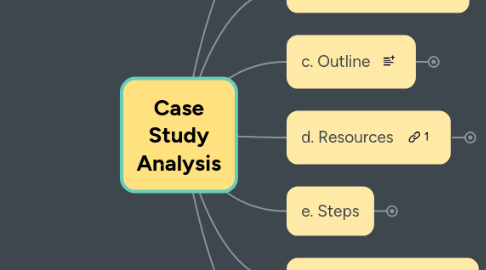
1. a. What it is
1.1. a versatile and effective teaching methods
1.2. a written description of a business situation
1.3. does not include analysis or conclusions of the situation, only the facts concerning the situation
1.4. helps in developing problem-solving skills and in applying theoretical knowledge to a practical problem
1.5. thus placing students in the role of decision-makers, forcing them to analyze the situation, and formulate strategies and recommendations
2. b. Related Literatures
2.1. Strategic Management and Business Policy. Thomas L. Wheelen, J. David Hunger
2.2. Strategic Marketing Problems: Cases and Comments. Roger Kerin, Robert Peterson
2.3. Reframing Business: When the Map Changes the Landscape, John Wiley and Sons. Richard Normann
2.4. Strategy and the Business Landscape. Pankaj Ghemawat
3. c. Outline
3.1. a. Current Situation
3.1.1. Current Performance
3.1.2. Strategic Postures
3.2. b. Strategic Managers
3.2.1. Board of Directors
3.2.2. Top Management
3.3. c. External Environment (EFAS)
3.3.1. Societal Environment
3.3.2. Task Environment
3.4. e. Internal Environment (IFAS)
3.4.1. Corporate Structure
3.4.2. Corporate Culture
3.4.3. Corporate Resources
3.5. f. Analysis of Strategic Factors
3.5.1. Situational Analysis (SFAS)
3.5.2. Review of Current Mission & Objectives
3.6. g. Strategic Alternatives & Recommended Strategy
3.6.1. Strategic Alternatives
3.6.2. Recommended Strategy
3.7. h. Implementation
3.7.1. Step by step detail aligned to recommended strategy
3.7.2. Main implementation actors
3.8. i. Evaluation & Control
4. d. Resources
4.1. Online databases (www.ecch.com)
4.2. books
4.3. companies
4.4. professors
4.5. students
5. e. Steps
5.1. 1. Comprehend the Case Situation
5.1.1. Standard Questions
5.1.1.1. What are the key issues
5.1.1.2. What is the environment
5.1.1.3. What are the solutions called for
5.1.1.4. What would you want to know from the key people
5.1.1.5. What are the actual outcomes of the current situation
5.1.1.6. What are the "ideal" outcome
5.1.1.7. What information is lacking
5.1.2. Keep in mind while reading
5.1.2.1. All behavior is caused, motivated, goal-directed
5.1.2.2. Separate fact from opinion
5.1.2.3. Get more information about the case
5.1.2.4. Separate symptoms from underlying causes
5.1.2.5. Avoid judgment; avoid premature solutions
5.2. 2. Defining the Problem
5.2.1. Questions to aid identification
5.2.1.1. Where is the problem, why is it a problem
5.2.1.2. What would happen if the "problem" were left alone
5.2.1.3. What standard is violated
5.2.1.4. What are the outcomes (ideal and actual)
5.2.1.5. How do key people feel about the problem and current outcomes
5.2.1.6. What type of problem is it
5.2.1.7. How urgent is the problem
5.2.1.8. What are the consequences (for the organization, the people)
5.2.1.9. How stable are present conditions
5.2.1.10. What information is lacking
5.2.1.11. What are the sources of available information
5.2.2. Traps in this stage
5.2.2.1. Suggesting a solution prematurely
5.2.2.2. Stating a problem in behavioral (personal) term
5.2.2.3. Not explicitly stating the problem
5.2.2.4. Blindly applying stereotypes to problems
5.2.2.5. Confusing symptoms with causes
5.2.2.6. Stating the problem as a disguised solution
5.3. 3. Identify the causes
5.3.1. Don't quit at the most obvious answer
5.3.2. Accept the multiple causality of events
5.3.3. There may be a number of viable ways to fit the data together
5.3.4. There is a great tendency to evaluate behavior as good or bad
5.3.5. The concern is not whether behavior is good or bad but why it occurred and its consequence
5.3.6. Be careful about hindsight
5.3.7. Avoid premature solutions and premature judgments
5.4. 4. Generating Alternative Solutions
5.4.1. What are the decision-maker's sources of power in the situation?
5.4.2. What are the possible leverage points?
5.4.3. Can individual behavior be changed?
5.4.4. What are the constraints on the solution?
5.4.5. What are the available resources?
5.4.6. Should others be involved?
5.5. 5. Decision
5.5.1. Criteria to evaluate alternatives
5.5.2. Considerations for alternatives
5.6. 6. Taking Action
5.6.1. Areas to consider
5.6.1.1. What are the leverage points for change
5.6.1.2. What are the decision maker's sources of power
5.6.1.3. What are the constraints on a solution
5.6.1.4. Does culture have to change
5.6.1.5. Will people resist change
5.6.1.6. Monitoring changes
5.6.1.7. The ramifications of implementing the plan
5.6.2. Stages of Implementation
5.6.2.1. Unfreezing
5.6.2.2. Change
5.6.2.3. Refreezing
